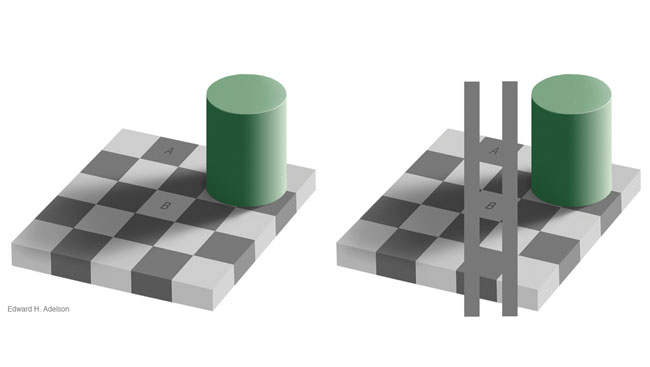Sensory Illusions
- Published1 Oct 2011
- Reviewed15 Feb 2012
- Author Debra Speert, PhD
- Source BrainFacts/SfN
Now you see it, now you don’t. Tricks and illusions are not just for magicians. Actually, brain researchers use these tools to learn about sensory perception. Continued research in this field not only helps to reveal how the human brain processes sensory information, but also may help design computer systems that can perform valued human tasks, like facial recognition or security screening.

Which square is darker, A or B? It turns out that they are exactly the same hue, but the brain interprets them differently because of the suggestion of shadow and the contrast between neighboring squares.
What you see isn’t always what you get. In fact, the brain makes best guesses about the outside world from surprisingly limited information. Research shows the brain reconstructs the rich tapestry that we sense and experience from bits of scattered data.
On rare occasions, the brain gets it wrong, resulting in an inaccurate perception — an illusion. But recent research suggests these illusions mean the brain is doing a good job of making sense of confusing situations.
Far from deceiving the brain, illusions represent important tools in perceptual research. From this research, scientists are learning:
- Which areas of the visual cortex may be important in perception and awareness.
- How the brain may use the same circuits to interpret motion information from vision and touch.
The visual system is quite good at interpreting shadows and contrast. In general, the brain interprets objects in shadow as brighter than they appear, and items placed next to darker ones are seen as lighter by contrast. By exploiting these two properties of visual perception, one brain researcher designed a clever optical illusion in which two squares on a checkerboard appear to be completely different hues, but are in fact the exact same shade.
Does this mean the brain failed? If the brain’s job is to be a light meter, then the answer may be yes. However, the brain’s real job is not to measure light, but to interpret visual signals to make sense of the world, and from this point of view the “illusion” is a sign of success. In a study of motion illusions, scientists found perceptual errors could be explained by assuming the brain is following an ideal set of computational rules. In other words, the “errors” are the natural outcome of the calculations the brain makes to interpret each and every visual experience.
Visual illusions have been useful in studying conscious awareness. Brain researchers used an illusion called “motion-induced blindness” to pinpoint the brain processes that are active when perception and reality part.
In the illusion, three immobile yellow dots are superimposed on a rotating grid of blue daggers. Participants are asked to observe a blinking green dot at the center of the whole image. As they do, the yellow dots appear to vanish for short periods of time as the blue grid rotates around.
In both monkeys and humans, researchers found similar brain regions are responsible for the illusion. One group recorded the electrical signals in monkeys and found three areas of the visual cortex were active during the illusion, but only one — known as V4 — predicted whether the observer “saw” the yellow dots. Brain imaging research in humans also showed V4 tracked awareness of the yellow dots, becoming more active when the dots appeared and less active when they disappeared.
Visual information is thought to pass from more general areas of the visual cortex, such as V1 and V2, on to so-called “association” areas that do more complex work, such as V4. These findings point to V4 as an important region in perception and awareness.
Recent research suggests illusions that fool different senses may use the same brain circuits. If you watch objects moving in one direction for long enough, immobile objects appear to move in the opposite direction. This phenomenon is known as an aftereffect. Researchers found after study participants were shown visual scenes moving in a single direction, the participants perceived stationary tactile stimuli — a row of vibrating pins placed on a finger — as moving in the opposite direction. In turn, tactile stimuli moving in one direction caused participants to perceive visual scenes as moving the opposite way.
These findings suggest the brain uses the same system to process visual and tactile motion. Future studies may indicate to what extent the brain circuits that process visual and tactile illusions overlap.
Has our increased understanding of sensory perception led to advances in artificial intelligence? Interestingly, brain researchers and computer scientists have not yet been able to design a machine that sees or senses as well as humans. So far, nothing has proved to be as complex and agile as the human systems of sensation and perception.
CONTENT PROVIDED BY
BrainFacts/SfN
Also In Archives
Trending
Popular articles on BrainFacts.org


















